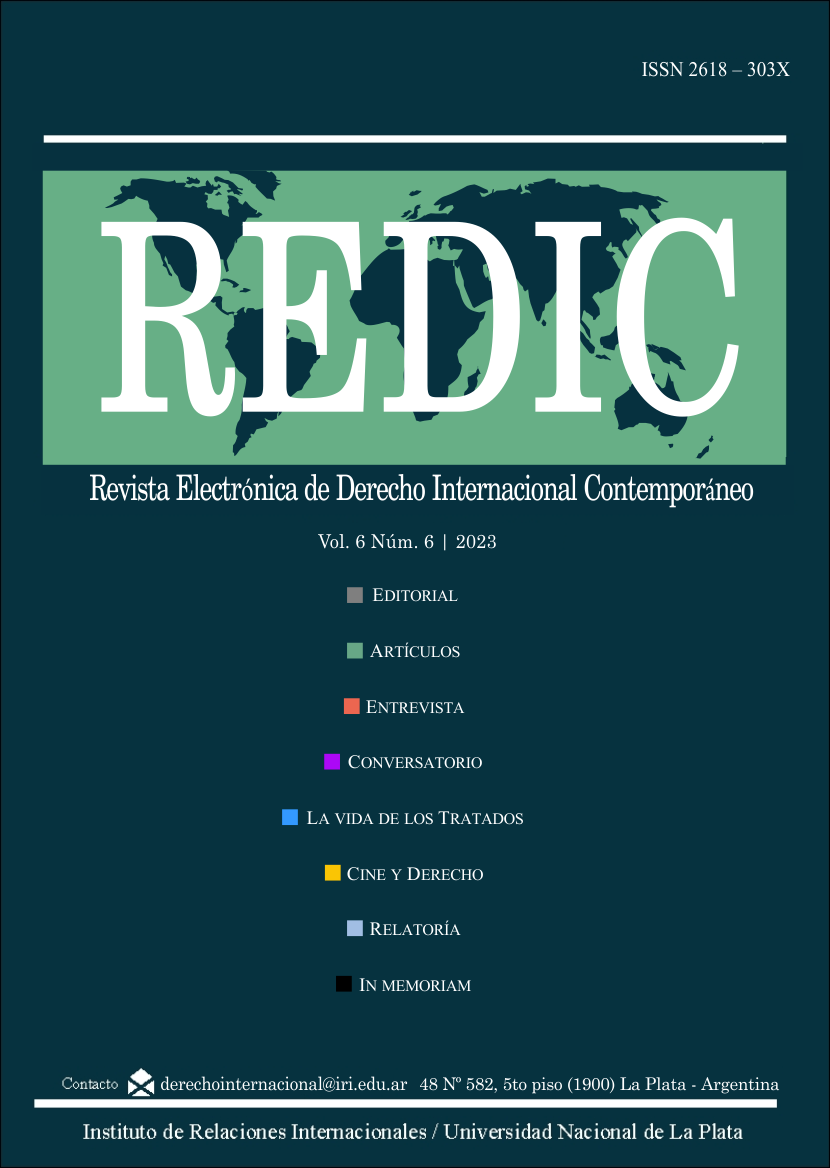The Global Compact for a Safe, Orderly and Regular Migration: Strengths and Weaknesses of a Soft Law instrument
DOI:
https://doi.org/10.24215/2618303Xe055Keywords:
migratory governance, soft law, migrations, follow-up mechanismAbstract
The 2016 New York Declaration and, later on, the Global Compact for a Safe, Orderly and Regular Migration from 2018 constitute a cornerstone in the regulation or governance of migratory flows. The latter has been proclaimed a non-binding instrument and, as a result, soft law; however, this type of law is no stranger to the rest of the legal system. Even though no obligations may be created by soft law which are legally binding to the States, it does give rise to several interesting interactions tackled in this article. We look at its possible interpretations and the possibility to be combined with (a few) other international provisions governing migration. A brief analysis of its very own follow-up mechanism is also included here, so as to frame the Compact in international migratory regulations and so as to shed light on its legal capabilities. Soft law being an increasingly common mechanism when facing global challenges, it is necessary to analyze it together with all other provisions from the legal system as well as to look into its potential when it comes to fulfilling its purpose via follow-up mechanisms differing from the traditional sanction method applied by hard law.
Downloads
References
Betts, A. (2018). The Global Compact on refugees: towards a theory of change. International Journal of Refugee Law, (30)4, 623-626. https://doi.org/10.1093/ijrl/eey056
Cachón Rodríguez, L. y Aysa-Lastra, M. (2019). El Pacto Mundial para la migración segura, ordenada y regular: un contrato social internacional. Anuario CIDOB de la Inmigración 2019, 84-95. https://doi.org/10.24241/AnuarioCIDOBInmi.2019.84
Capone, F. (2020). The alleged tension between the global compact for safe, orderly and regular migration and state sovereignty: Much ado about nothing? Leiden Journal of International Law, 33(3), 713-730. https://doi.org/10.1017/S0922156520000254
Chetail, V. (2019). International migration Law. Oxford University Press. https://doi.org/10.1093/law/9780199668267.001.0001
Dasser, F. (2021). “Soft Law” in international commercial arbitration. Collected Courses of The Hague Academy of International Law (Volumen 44).
Fajardo del Castillo, T. (2019). El Pacto Global por una migración segura, ordenada y regular: un instrumento de soft law para una gestión de la migración que respete los derechos humanos. Revista Electrónica de Estudios Internacionales, (38), 1-34. https://doi.org/10.17103/reei.38.02
Fernando-Gonzalo, E. (2023). La informalización de la política de readmisión europea ante el Global Compact on migration. En J. Martín y Pérez de Nanclares y D. González Herrera (Coords.), Desafíos jurídicos en la gestión internacional y europea de los flujos migratorios (pp. 239-254). Tirant Lo Blanch.
Gammeltoft-Hansen, T., Guild, E., Moreno-Lax V., Panizzon, M. y Roele, I. (2017). What is a compact? Migrants’ rights and state responsibilities regarding the design of the UN Global Compact for safe, orderly and regular migration. Raoul Wallenberg Institute of Human Rights and Humanitarian Law. https://dx.doi.org/10.2139/ssrn.3051027
Höflinger, T. (2020). Non-binding and therefore irrelevant? The Global Compact for migration. International Journal, 75(4), 662-672. https://doi.org/10.1177/0020702020975108
Panizzon, M. y Vitiello, D. (4 de marzo de 2019). Governance and the UN Global Compact on migration: just another soft law cooperation framework or a new legal regime governing international migration? Blog of the European Journal of International Law: Talk! https://www.ejiltalk.org/governance-and-the-un-global-compact-on-migration-just-another-soft-law-cooperation-framework-or-a-new-legal-regime-governing-international-migration/
Peters, A. (21 de noviembre de 2018). The Global Compact for migration: to sign or not to sign? Blog of the European Journal of International Law: Talk! https://www.ejiltalk.org/the-global-compact-for-migration-to-sign-or-not-to-sign
Roele, I. (2017). What are the forms of UN international agreements/understandings and what is their legal effect? En T. Gammeltoft-Hansen, E. Guild, V. Moreno-Lax, M. Panizzon y I. Roele (Eds.), What is a compact? Migrants’ rights and state responsibilities regarding the design of the UN Global Compact for safe, orderly and regular migration. Raoul Wallenberg Institute of Human Rights and Humanitarian Law. http://dx.doi.org/10.2139/ssrn.3051027
Salomon, M. K. y Sheldon, S. (2018). The Global Compact for migration: from the sustainable development goals to a comprehensive agreement on safe, orderly and regular migration. International Journal of Refugee Law, 30(4), 584-590. https://doi.org/10.1093/ijrl/eey065
Santos Vara, J. y Pascual Matellán, L. (2020). The Global Compact on migration: convergence or divergence with EU policies? En E. Fahey (Ed.), Framing Convergence with the Global Legal Order (pp. 163-175). Hart Publishing. https://doi.org/10.5040/9781509934409.ch-009
Van Loon, H. (2016). El desafío doble de la migración internacional. Revista Española de Derecho Internacional, 68(2), 15-17. https://www.revista-redi.es/redi/article/view/721
Additional Files
Published
How to Cite
Issue
Section
License
Copyright (c) 2023 Elsa Fernando-Gonzalo

This work is licensed under a Creative Commons Attribution-NonCommercial-ShareAlike 4.0 International License.
Aquellos autores/as que tengan publicaciones con esta revista, aceptan los términos siguientes:
- Los autores/as conservarán sus derechos de autor y garantizarán a la revista el derecho de primera publicación de su obra, el cuál estará simultáneamente sujeto a la Licencia de reconocimiento de Creative Commons (BY-NC-SA) 4.0 que permite a terceros compartir la obra siempre que se indique su autor y su primera publicación esta revista, no se haga uso comercial, y si se remezcla, se transforma o se crea a partir del material, se debe distribuir bajo la misma licencia del original.
- Los autores/as podrán adoptar otros acuerdos de licencia no exclusiva de distribución de la versión de la obra publicada (p. ej.: depositarla en un archivo telemático institucional o publicarla en un volumen monográfico) siempre que se indique la publicación inicial en esta revista.
- Se permite y recomienda a los autores/as difundir su obra a través de Internet (p. ej.: en archivos telemáticos institucionales o en su página web) antes y durante el proceso de envío, lo cual puede producir intercambios interesantes y aumentar las citas de la obra publicada. (Véase El efecto del acceso abierto).





















